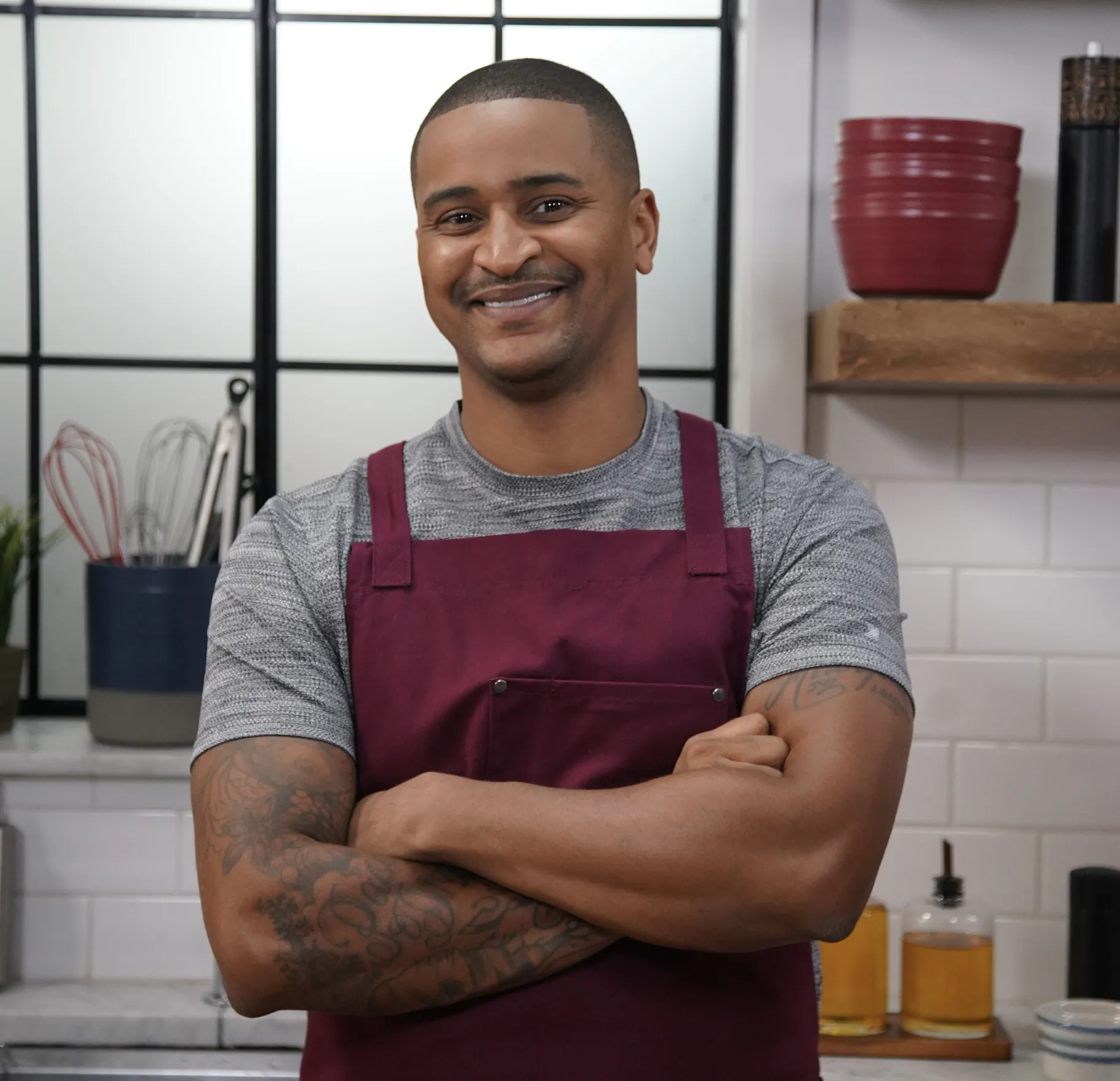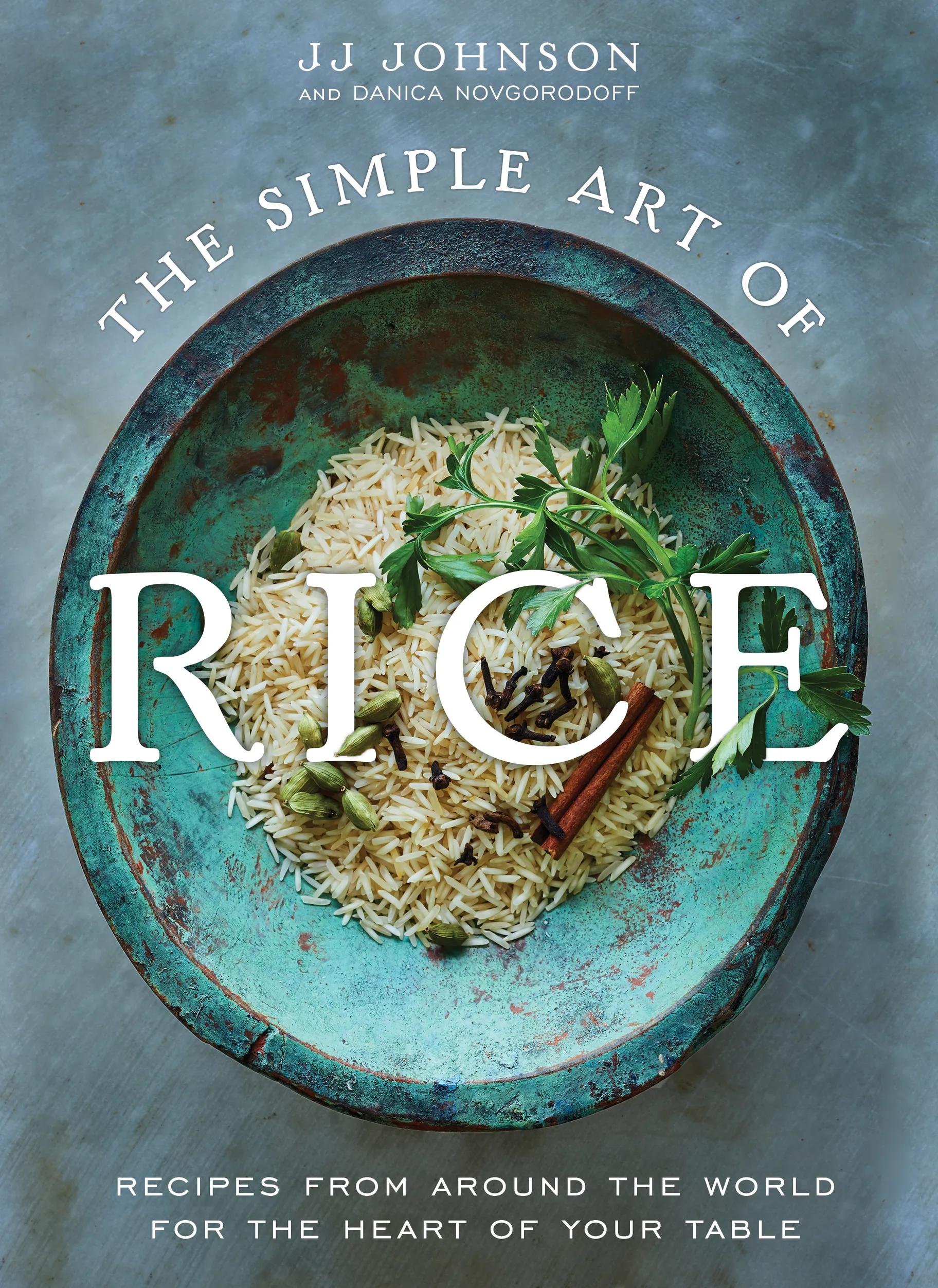Each semester, Dr. Amber Spry, who teaches a class on Identity Politics in the United States at Brandeis University, begins her class with an exercise known as a "rice breaker," asking students how their family cooked rice when they were growing up. The simple question reveals volumes. FieldTrip in Harlem, the first outpost in what is now a restaurant group, highlights rice traditions around the world. The chef behind the concept is JJ Johnson, who has written a new cookbook, The Simple Art of Rice: Recipes from Around the World for the Heart of Your Table.
Evan Kleiman: I'm happy you're here with us. We have to know: What's your answer to our "rice breaker" question? How did your family cook rice when you were growing up?
JJ Johnson: My grandmother, Iris, cooked rice in one of those steel looking pots. She washed her rice. She would use her finger as a trick to measure the rice. And those dishes would be anything from arroz con gandules to paella to chicken and rice to the perfect pot of fluffy white rice. But it was always done on top of the stove.
I understand it was a trip to Ghana that changed the way that you thought about rice. Could you share your thoughts on rice, from culinary school to that first taste in Ghana?
Culinary school, I'll start there. It was rice pilaf. That was the only rice and some fried rice in Asian cookery. It was really brushed over. There wasn't any talk about technique or the history or how essential it is to the diet. Then, when I went to Ghana, the first moment around rice with people going crazy was at a woman's home. She was making jollof rice and everybody was waiting. It was like that moment of being at a concert and you're waiting for the artist to come out and you've been waiting all night. I'm like, why is everybody so antsy? It's just rice. Why aren't we excited about the goat? Why aren't we excited about the guinea hen stew? But I know why everybody was excited.
That moment of me having Ghanaian jollof changed my whole perspective on rice. The grain was fluffy. It was spicy. There was nuttiness to it that didn't taste like any rice I'd ever had before. It made me dive really deep. In 2011 and 2012, I started diving really deep into rice and researching it, where the grains come from. Why is it so significant? Going back to your first question, there's so many grains of rice, there's so many significant grains that pay impact to history across the world. That's why I started to dig really deep.
Yeah, there are 28 different rices that you feature in the book, which is kind of crazy. There's one picture in the book that made me stop and I started counting across the columns and down the line. When I think about it, most people have cooked with two or three, maybe four kinds of rice. Did you immediately embrace them all? Or were some harder to center with the way that you cook?
Most of us are eating bleached, enriched rice called Carolina rice, or some type of white American rice that's bleached and enriched and I tell people not to eat. That was a first step for me to get past. I gotta let go of this rice and start embracing the grain that is of America, which is Carolina gold rice. How can I embrace that? How can I learn about it, the essence of it, why it was taken off the shelf, why it was a lost crop? How do I embrace that? That allowed me to really embrace all the other grains.
I probably have five or six grains that I am constantly cooking in my household — jasmine rice, some type of basmati, black rice, broken rice or pearl rice, Carolina gold or Middlins. Those are the grains that are in my house but I use each grain in a different way. That's the beauty of rice. You can't just think, "Oh, I'm gonna use basmati" or "I'm just gonna use jasmine" and everything's gonna come out great. That's not how it goes. It's kind of like pasta, right? You use different shapes of pasta for different types of sauces or meats. That's the same thing about rice. But the difference with rice is that it makes your life so much easier because you have a good amount of left over for the next day or the day after that you can do other things with. That's how I embraced the grain. Then I started going into, "What about emerald green? Or what about bomba? What about California white rice?" You then want to graduate into these other rices because you realize that it plays a significant part based on where people live or that grain you want or need or it has some great flavor to it or it's gonna help you cook a dish better.
Once you were turned onto rice and you really began doing the research, what did you learn about yourself?
A lot of people do these ancestry things that tell them about who they are. I've never done that. But the rice has told me about myself. The rice my grandmother cooked told me, "Ooh, we are Puerto Rican." What part of Puerto Rico are we from based off the way she cooks that dish? Or my grandfather is from Mississippi. He puts okra in his gumbo and pours it on top of the rice. That points you to Mississippi, very close to the coast of Louisiana. Rice can tell you about history, about your family, about where you're from because where you're from, you start to cook with other ingredients around you that go on the rice. That's why you constantly see rice and beans or seafood in rice or you see spices. These ingredients are also growing beside the rice in that region and they will tell you about yourself, your family or the people. That's why I say rice is culture. It is made up of somebody's culture in that dish or in that grain or where it's grown.

Chef JJ Johnson recalls the uninspired rice pilaf he learned to make in culinary school before a trip to Ghana changed how he approached the grain. Photo courtesy of JJ Johnson.
I remember being afraid to cook rice a million years ago, before I was going out with a Persian man for many years, and that knocked the fear of rice out of me. But I remember when I used to worry about making mushy rice before rice cookers were ubiquitous and everywhere. You have a really thorough rice cooking troubleshooting section, which is awesome. What are some of the most important things we should keep in mind when we're cooking rice on the stove?
The most important thing that I want people to realize is that rice doubles in size. If you've been cooking rice and you use a small pot, you put in three cups of rice and it's growing to the top of the pot. You're like, "Why is it so crunchy in the bottom mushy?" Because the rice didn't expand. It doubles in size. So you need the right size pot to make perfectly cooked rice. I would say that's the first step.
You have the pot, you wash the rice, you put the rice in the pot, you use your third finger, you bring the liquid up to your first knuckle, you put the top on, you bring it to medium heat, you don't shake it, you don't open the top, you don't stir it, you let it go for 22 to 25 minutes, you take it off the heat, you fluff it and you add salt to it. You put the top back on for about five more minutes and let it rest and you have this perfect pot of rice.
I know I said it like it's so simple, but it really is. It's very easy to do. I think a lot of us are so used to making pasta that we stir the pasta or we shake the pot. We don't want to leave things alone. Rice is one of those ingredients that want to be left alone. You might have somebody in your family that's sometimes like "Okay, just give me some space." That's what rice is once it gets in the pot. It wants to do its thing.
Why are we fluffing the rice? What's the deal with taking a fork and fluffing the rice and then putting the top back on?
When you're fluffing the rice, it allows for the grains to not stick together. That initial first rice starch doesn't stick together. It allows you to season your rice when you're fluffing it because when you put the salt in the pot, it tightens up the grain and doesn't allow it to burst. Also, while you're fluffing the rice, you see that there's some crunchy parts of the rice stuck to the bottom of the pan. The reason why I tell you to fluff the rice then let it rest is because in that resting process, the bottom of the pot, that crunchy part, will release. So when you pull off that first part of rice, the bottom part will slide right out. You don't have to use that elbow grease to be scrubbing out the rice grains in the bottom that people hate.
Let's talk about sourcing. Do you want to shout-out any particular online sources or places people can go to source different kinds of rice?
I give a big shout-out to Glenn Roberts at Anson Mills, he's a mentor to me in all things around rice. They've done a great job of bringing Carolina gold and Charleston gold back on the map. They deserve all that credit. So I give a big shout out to them. There's a lot of great rice farmers around. New Jersey's Blue Moon Acres. Three Brothers in Hudson Valley, New York. There are so many. What I'm seeing is local grocery stores starting to carry freshly milled rice grains in the American South, which means there's a whole rice movement coming. Once that happens, I think that will start to change how we grow rice because it's so tied to climate change.
I'm always supporting some of those local rice farmers I just mentioned and always looking for new rice farmers. I try to tell people, if you go to the farmers market and you buy duck from a duck farmer, nine out of 10 times they're also growing rice because the ducks are swimming in the same water that they're growing the rice in.
Could you pick a recipe or two from the book that you think everyone would love to try?
Right now, I'm re-cooking my way through the book. My favorite dish right now is cinnamon lamb rice. It's a one pot-dish that I love. A dish I've been making with my kids are the rice cookies, which are very cool and tasty and light and airy and chewy and moist. I'm always trying to upgrade the cabinet or the cupboard. I have rice flour in my house and I was like, "Okay, it's sitting here. Let's try to make cookies." That's how that whole rice cookie thing started. It's gluten-free and it bakes beautifully. It has the essence of warming spice. It's a great foundational cookie that you can then add other things to as you get comfortable with it — chocolate chips, nuts. It gives you that playing ground to be a great foundation, so you can build on it.

"The Simple Art of Rice" features 28 varieties, going beyond the bleached and enriched white grain rice in American pantries. Photo courtesy of Flatiron Books.
Spiced Rice Cookies
Makes 4 dozen cookies
Active Cook Time: 35 minutes
These chunky cookies, made with white or brown puffed rice (yes, the kind sold in the breakfast cereal aisle) are both airy and chewy, with a hint of autumn spices, chocolate chips, and a light coconut flavor from coconut palm sugar (also known as coconut sugar). Look for sugar made from the coconut palm—most large supermarkets will carry it, or order it online—rather than palm sugar, which is made with the sap of the date palm tree. If you’re not a fan of chocolate in your cookies, you can substitute a cup of finely chopped nuts or dried fruit. These sturdy cookies keep well and travel well. Stored in an airtight container, they will stay fresh for a week or longer. If you can’t fit all your cookie dough on two baking trays, use another tray, or bake a second round.
Ingredients
- ½ pound (2 sticks) unsalted butter, at room temperature
- 1½ cups packed coconut palm sugar
- 1 teaspoon ground cinnamon
- ½ teaspoon ground ginger
- 2 teaspoons vanilla extract
- 1 teaspoon baking soda
- ½ teaspoon fine sea salt
- 2 large eggs, at room temperature
- 2¼ cups all-purpose flour
- One 11.5-ounce bag semisweet chocolate chips (see headnote)
- 1 cup unsweetened coconut flakes
- 2 cups puffed white or brown rice cereal
Instructions
-
Preheat the oven to 350 degrees F. Line two large sheet pans with parchment paper.
-
In the bowl of a stand mixer fitted with the paddle attachment, combine the butter, coconut palm sugar, cinnamon, ginger, vanilla, baking soda, and salt and mix at medium speed until creamy, about 2 minutes. Add the eggs one at a time, beating well after each addition.
-
Reduce the speed to low and gradually add the flour, mixing just until incorporated. Add the chocolate chips, coconut flakes, and puffed rice and mix until well combined.
-
Using a 1-ounce scoop or a large spoon, drop mounds (about 2 tablespoons each) of dough 2 inches apart onto the prepared baking sheets.
-
Bake until the cookies are golden brown at the edges and slightly soft in the center, about 10 minutes. Remove from the oven and allow the cookies to cool and firm on the pans for about 15 minutes, then transfer to a wire rack to cool completely.
